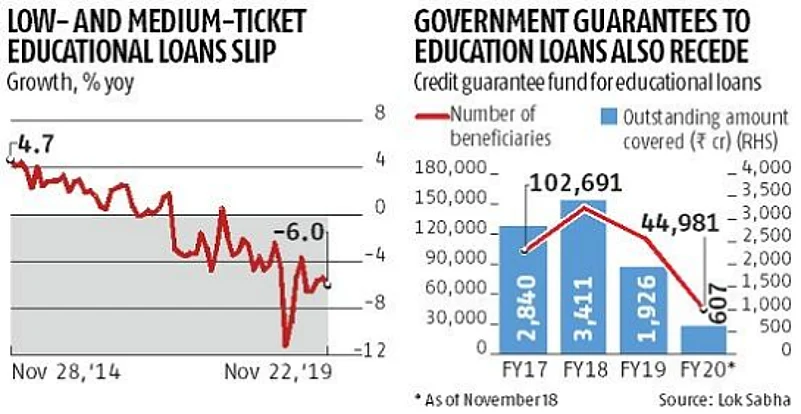Rising costs have made it difficult for parents to invest in their children's education even though, “Investment in education pays the best interest”. An MBA from ISB will set you back by Rs 40 lakh in 2021, which would have been Rs 26 lakh in 2016. A similar rise is seen in the cost of education in the U.S. Harvard University charged its international students $ 60,659 as tuition fees in the year 2016, which has shot up to $ 76,479 for the 2021-22 academic year. As a parent, financing the higher education of your child becomes easier with education loans.
Advertisement
If we chart the course of education loans in India, the data will convey a simple truth- Even with the rising cost of education, the number of education loans is dwindling. There has been a steady decline in the number of education loans approved since the end of 2016. A lot of reasons attributed to this decline.To name a few - initially, it was the demonetisation, then the ever-increasing volume of non-performing assets (NPA), and the most recent, the Covid-19 pandemic. But it is the NPAs that take the cake and the cherry too. The NPA in education loans is much higher than any other segment.
Advertisement

The lenders found a unique solution to this conundrum - throttling the low-value loans and sanctioning big-ticket loans. It is noted that education loans had shrunk almost 25 per cent by 2019 in the pre-pandemic world. The number of loans issued in 2015 stood at 3.34 lakh, whereas in 2019, the number of loans issued was only 2.5 lakh - a drastic drop in the number of students benefiting from education loans. But where the number of loans is declining, the value of loan amounts has increased. In the fiscal year 2019, the total loan amount disbursed is Rs. 22,550 crore, whereas the total loan amount disbursed in the fiscal year 2016 was Rs. 16,800 crore - a staggering 32 per cent increase in the loan amount disbursed. This is indicative that banks are not playing the volume game anymore. The focus has shifted to sanctioning loans with high-value; it’s a value game now.

These numbers are indicative of the scenario before the pandemic hit. The demand for education loans hit a new high during the pandemic as people rushed to enroll in a short-term upskilling course or upgrade to an executive course. Apart from domestic upskilling, there was also an increase of 35 per cent in the number of individuals applying for abroad universities. The demand has certainly increased during the Covid-19 pandemic, but the disbursals remain on the lower side with only Rs 11,000 crore disbursed in the 12 months through September 2020.
‘Model Education Loan Scheme’, formulated by the IBA, mandates that banks provide collateral-free education loans lower than Rs 7.5 lakh. The IBA has provided broad guidelines for the lenders to follow, giving them the flexibility to offer varying education loan products to the customer. However, banks grant these low-ticket education loans without scrutinizing the financial ability and the future employability outcome of the applicants. The lack of employability combined with the fact that these are low-ticket unsecured loans, with no fear of property being possessed, is contributing more to the increasing NPA. Whereas loans with a value above Rs 4 lakh, require a guarantor, and loans above Rs 7.5 lakh, require a collateral. A student defaulting on a secured education loan runs the risk of losing the collateral, and therefore, they think twice before defaulting. As of 31st December 2021, 9.55 per cent of the education loans lent by the public sector banks were considered NPAs. Since low-ticket unsecured education loans have a higher rate of contribution to the increasing NPAs, banks have shifted to high-ticket secured education loans. This shift has done two main things-firstly, it impacted the low-income section of the society and created an education disparity, and secondly, it created room for EdTech companies, to bridge the gap that traditional lenders could not.
Advertisement
The government of India started various interest subsidy schemes that helped reduce the financial burden on the low-income section as well as incentivize lenders to provide education loans, such as the Central Sector Interest Subsidy scheme. While there are characteristics of this scheme that need improvement such as the limit on the loan amount, it is still a step in the right direction. Banks will also have to make adjustments and follow a model where they grant education loans based on factors like students’ future earning potential, the ranking of the college and course, and the financial strength of the parents. Non-Banking Finance Companies (NBFC) already take into account these elements and boast of lower NPA ratios. Another solution to boost the number and value of education loans, is risk-based pricing. Not every student walks out of an NBFC with the same interest rate. The rates are offered based on the risk the lender is taking.But a student with an excellent academic record might even get a lower interest rate. While the risk of any asset turning bad is never zero, taking into account these factors, lessens the risk and assists in evaluating the creditworthiness of the student.
Advertisement
With the augment of digitalisation, new education technology, and EduFinance companies have sprung up catering to sections that were ignored previously. These EdTech companies and startups are focusing on the smaller segments of the market, financing short-term upskilling courses and programs, which were looked over by traditional lenders like banks and NBFCs. They have started pilot programs wherein they provide zero EMI loans, while also working with banks and NBFCs to tweak loan mechanics to serve the student as well as the lender in a more efficient manner. It is still in the early stage but has shown commendable performance and promise. GyanDhan, a FinTech startup, has ventured into the domestic market after helping students finance their abroad education. Their focus is on providing students an opportunity to further their education without the burden of paying huge sums of money out of pocket at one go. Another Digital non-Banking firm, Eduvanz has so far disbursed loans worth Rs 300 crore to students to fund their school fees, college fees, and to working professionals, enrolled in upskilling courses. Propelld, a digital lending startup, has partnered with various lending institutions and NBFCs, providing tailor-made education loan products to students for vocational courses. They aim to provide credit options to students with a low credit score or non-existent credit history.
Advertisement
With the total education loan book at a meager $ 14 billion in a sector that witnesses an annual spend in excess of $ 40 billion, the scope for growth is immense. While the current focus is on ‘consumer durable’ financing, the future of education rests on employability-based financial solutions including Income Share Agreements (ISA), a method adopted by several universities in the USA, and development bonds in addition to traditional education loans. Nearly 800 Purdue University students have received
$ 9.5 million in funding through Income Share Agreements. There are similar success stories from more US universities like Clarkson University, University of Utah, following this model helping students finance their education. In the coming years, borrowers and lenders should also expect sachetisation - providing finance of small amounts for modules rather than degrees - which will increase accessibility for the broader population.
Advertisement
The author is Founder, GyanDhan
DISCLAIMER: Views expressed are the author’s own, and Outlook Money does not necessarily subscribe to them. Outlook Money shall not be responsible for any damage caused to any person/organisation directly or indirectly.















 Just one email a week
Just one email a week